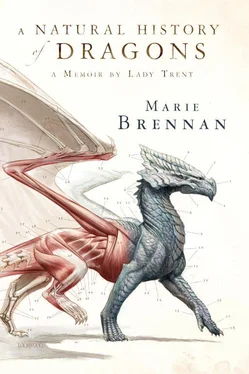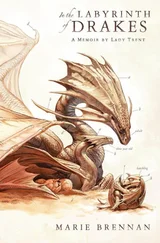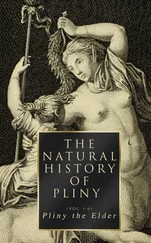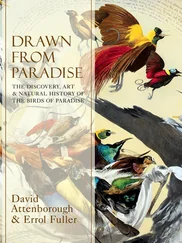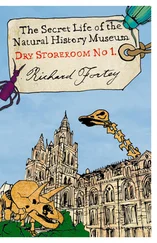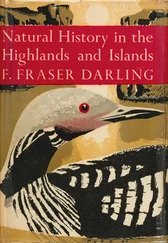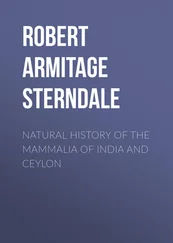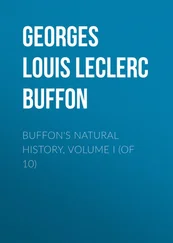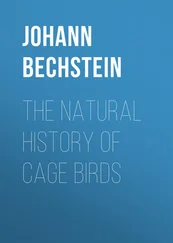“In here,” the naturalist said, in ringing tones that drew more eyes than usual, “we keep the crowning jewels of His Majesty’s collection, only recently acquired. I beg the ladies to have a care, for many find the creatures within to be frightening.”
One may measure the extent to which I had cut myself off from my old interests that I did not have the slightest clue what the king had acquired, that lay beyond those doors.
Mr. Swargin opened them, and we filed through into a large room enclosed by a dome of glass panels that let in the afternoon sunlight. We stood on a walkway that circled the room’s perimeter and overlooked a deep, sand-floored pit divided by heavy grates into three large pie-slice enclosures.
Within those enclosures were three dragons.
Forgetting myself entirely, I rushed to the rail. In the pit below me, a creature with scales of a faded topaz gold turned its long snout upward to look back at me. From behind my left shoulder, I heard a muffled exclamation, and then someone having a fainting spell. Some of the more adventurous gentlemen came to the railing and murmured amongst themselves, but I had no eyes for them—only for the dragon in the pit.
A dull clanking sounded as it turned its head away from me, and I saw that a heavy collar bound its neck, connecting to a thick chain that ended at the wall. The gratings between the sections of the pit, I noticed, were doubled; in between each pair there was a gap, so the dragons could not snap at one another through the bars.
With slow, fascinated steps, I made my way around the room. The enclosure to the right held a muddy green lump, likewise chained, that did not look up as I passed. The third dragon was a spindly thing, white-scaled and pink-eyed: an albino.
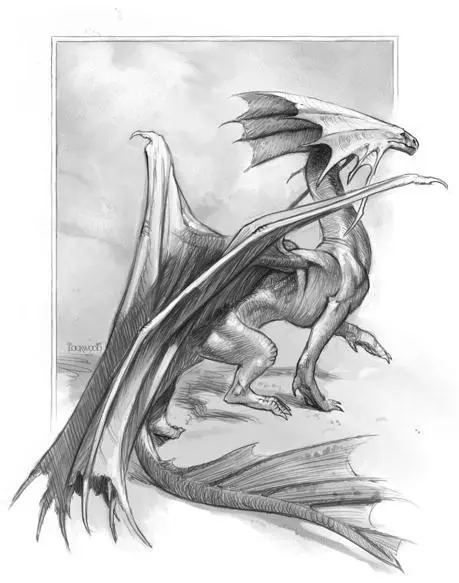
AKHIAN DESERT DRAKE
Mr. Swargin waited at the rail by the entrance. Sparing him a glance, I saw that he watched everyone with careful eyes as they circulated about the room. He had warned us, at the outset of the tour, not to throw anything or make noises at the beasts; I suspected that was a particular concern here.
The golden dragon had retired to the farthest corner of its enclosure to gnaw on a large bone mostly stripped of meat. I studied the beast carefully, noting certain features of its anatomy, comparing its size against what appeared to be a cow femur. “Mr. Swargin,” I said, my eyes still on the dragon, “these aren’t juveniles, are they? They’re runts.”
“I beg your pardon?” the naturalist responded, turning to me.
“I might be wrong—I’ve only Edgeworth to go by, really, and he’s sadly lacking in illustrations—but my understanding was that species of true dragon do not develop the full ruff behind their heads until adulthood. I could not get a good view of the green one the next cage over—is that a Moulish swamp-wyrm?—but these cannot be full-grown adults, and considering the difficulties of keeping dragons in a menagerie, it seems to me that it might be simpler to collect runt specimens, rather than to deal with the eventual maturation of juveniles. Of course, maturation takes a long time, so one could—”
At that point I realized what I was doing, and shut my mouth with a snap. Far too late, I fear; someone had already overheard. From the other side of me, I heard another voice say, “The albino is certainly a runt, and I cannot determine its species.”
If you wish, gentle reader, you may augment your mental tableau with dramatic orchestral accompaniment. I suggest something in a minor and ominous key, as that is what went through my own head as I realized just how thoroughly I had outed myself as ink-nosed. Heavy with dread, I dragged my eyes away from the gold dragon and up to the gentleman who had spoken.
A pair of trim feet in polished leather shoes; that was what I saw first. Then a goodly length of leg; then narrow hips and a waist not yet thickened by age. One long-fingered hand, resting on the sculpted bronze of the railing. Shoulders acceptably broad, without being so wide as to produce that triangular appearance I find unattractive, though it appeals to some ladies. A long oval of a face, with firm lips, a straight nose, good cheekbones, spectacles in front of clear hazel eyes, topped off with a neatly trimmed cap of brown hair.
Another lady, perhaps, might have been able to tell you what he was wearing. For my own part, I viewed him with a naturalist’s eye, seeing size, conformation, coloration. And identifying marks: the handkerchief tucked into his breast pocket was embroidered with a coat of arms, argent, three arrows in hand sable.
The Camherst coat of arms, belonging to a wealthy baronet. The age and the spectacles made this the baronet’s second son: one Jacob Camherst, twenty-three years of age, educated at Ennsbury, and well situated with investments. The matchmaker who gave his name to my father had marked him as an outside chance at best; he would make an agreeable if not spectacular catch someday, but he showed no inclination yet to wed.
Which was the one thing that saved me from utter mortification. I had not jeopardized any of my good prospects—provided I did not give Mr. Camherst reason to gossip about me to anyone else.
“I beg your pardon,” the gentleman said, focusing on me. “I didn’t mean to interrupt.”
He hadn’t interrupted; I’d stopped myself before he could. The stopping, however, had left me tongue-tied, a state from which I was saved only by the arrival of my wayward sibling. “Of course not; that’s a brother’s job,” Andrew said, swooping in to offer his hand for Mr. Camherst to shake. “Andrew Hendemore. My father is Sir Daniel, of Norringale in Tamshire. This is my sister, Isabella.”
My social graces were not the best in those days—nor are they the best now; they have been improved only by the greater dignity of years—but two years of practice had rescued them from complete disgrace; I managed a credible curtsy despite the mixture of panic and yearning unsettling my heart. Panic for the man, yearning for the dragons; most young ladies would feel the reverse. “Charmed,” I said, as Mr. Camherst took my hand and kissed the air above my fingers.
He gave his name in reply, but then turned his attention away from me and back to Mr. Swargin. “The albino, sir?”
“A Vystrani rock-wyrm,” the naturalist said. “They are naturally grey in coloration, of course, but you are correct; that one is a true albino, as you can see by the eyes.”
Andrew was making comical faces behind Mr. Camherst’s back. I knew what he wanted; it would amuse him greatly to watch me babble on further about dragons. Mama would have fits merely knowing I had been here, though. Any report of my conduct must be above reproach. If I were wise, I would take my leave of Mr. Camherst and Mr. Swargin, before temptation became too much.
I was not, of course, wise. Just as Manda Lewis’s impressions of the world had been informed by her reading—leading her to expect balls, duels, and conveniently timed thunderstorms out of life—so, too, had mine; but what I expected was intellectual commerce between equals. I had, you understand, read a great many works by men, who regularly experience such things, and had not realized the unlikelihood of such things for me. In my naive, sixteen-year-old way, I thought Jacob Camherst and I might be friends.
Mr. Swargin closed the matter by including me in his reply to Mr. Camherst. “Miss Hendemore is correct; all three are runt specimens. The green is a Moulish swamp-wyrm, and the gold, a desert drake from the south of Akhia. His Majesty would very much like to have full-grown adults, but they could not possibly be kept within a menagerie. No doubt you’ve noticed the gratings that keep them apart from one another, and at that, we’ve had to keep a muzzle on the swamp-wyrm. He will persist in breathing at everything, and while the other two endure it better than we humans do, no one enjoys it very much.”
Читать дальше
